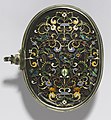Category:Cloisonné
emalierska technika zdobnicza, polegająca na wypełnianiu emalią pól (komórek) wykonanych wcześniej na metalowym przedmiocie przez przylutowanie do niego pasków metalu lub spłaszczonego drutu | |||||
| Prześlij plik multimedialny | |||||
| Jest to | |||||
|---|---|---|---|---|---|
| Podklasa dla |
| ||||
| Kraj pochodzenia | |||||
| Inne niż | |||||
| |||||
Cloisonné is an ancient technique for decorating metalwork objects, in recent centuries using vitreous enamel, and in older periods also inlays of cut gemstones, glass, and other materials. The resulting objects can also be called cloisonné. The decoration is formed by first adding compartments (cloisons in French) to the metal object by soldering or glueing silver or gold wires or thin strips placed on their edges. These remain visible in the finished piece, separating the different compartments of the enamel or inlays, which are often of several colors. Cloisonné enamel objects are worked on with enamel powder made into a paste, which then needs to be fired in a kiln.
Derivated from this technique, in late 19th century, some glass maker developed the cloisoneé glass, a complex technique with brighting results. Discovered by the french painter Amédée Navarein and developed by Theophil Pfister (USA) and Emil Barthels (Germany) under "The glass cloisonné Co." denomination, in London. Beside this company, just some art nouveau artists created cloisoneé glasses, as Frederic Vidal in Catalonia, John La Farge in USA or Luigi Fontana in Italy. Because of conservation difficulties, just a few number of pieces have survived.
Podkategorie
Poniżej wyświetlono 2 spośród wszystkich 2 podkategorii tej kategorii.
Pliki w kategorii „Cloisonné”
Poniżej wyświetlono 53 spośród wszystkich 53 plików w tej kategorii.
-
1963-03 1963年 景泰蓝香炉.jpg 464 × 565; 93 KB
-
Arte ostrogota, orecchino, da domagnano, san marino, 500 ca.JPG 393 × 1191; 401 KB
-
Blue Gunto, Cloisonné Styled.png 978 × 744; 370 KB
-
Byzantium, 9th century - Ring - 1937.4 - Cleveland Museum of Art.tif 3312 × 2998; 28,44 MB
-
Clevelandart 1926.246.jpg 3155 × 3400; 2,07 MB
-
Cloisonnebeads.jpg 400 × 300; 30 KB
-
Cloisonné and bisque woman with carved stone dog.JPG 1712 × 3860; 730 KB
-
CPAddingFrit.jpg 600 × 400; 59 KB
-
CPPaternAndCloisonsDetail.jpg 600 × 428; 62 KB
-
CPPatternAndCloisons.jpg 600 × 400; 65 KB
-
Descent of the Holy Spirit icon, 12th century. National Museum of Georgia.jpg 1536 × 1990; 1,13 MB
-
Dukász Mihály VII.jpg 225 × 202; 16 KB
-
Enamel paints.JPG 3264 × 2448; 1,91 MB
-
Estambul, tiendas 1998 06.jpg 889 × 694; 1,11 MB
-
GNM - Gotisches Ohrgehänge.jpg 1712 × 2560; 745 KB
-
GNM - Westgotische Gürtelschnalle 1.jpg 2560 × 1712; 1,3 MB
-
GNM - Westgotische Gürtelschnalle 2.jpg 2560 × 1712; 1,3 MB
-
GNM - Westgotische Gürtelschnalle 3.jpg 2560 × 1712; 1,16 MB
-
Herter Brothers - Secretary Cabint - left panel detail - HLAMBG.png 2166 × 1757; 10,18 MB
-
Herter Brothers - Secretary Cabint - right panel detail - HLAMBG.png 1963 × 1680; 8,71 MB
-
Inkpot (AM 1932.233-2).jpg 2448 × 3264; 1,4 MB
-
Jarrón de estilo islámico.jpg 3072 × 4096; 3,15 MB
-
Jingtailan yinnihe.JPG 448 × 312; 20 KB
-
Kadzielnica Cloisonné (Poznan).jpg 2028 × 1481; 612 KB
-
Khalili Collection Enamels of the World FAB747.jpg 3309 × 2500; 1,01 MB
-
Khalili Collection Japanese Meiji Art E064.jpg 3173 × 2500; 1,28 MB
-
Matching Pair of Cloisonné Vases, c. 1800-1894.jpg 6137 × 5016; 1,07 MB
-
Orecchino a pendente, arte ostrogota da domagnano (s. marino), 500 ca.JPG 538 × 1104; 348 KB
-
QueensHeaddress.jpg 800 × 600; 83 KB
-
Reloj chinoisserie, Museo Bellver.jpg 2794 × 3725; 3,74 MB
-
S03 03 02 004 image 58.jpg 1062 × 1200; 957 KB
-
S03 03 02 008 image 59.jpg 1200 × 784; 706 KB
-
S03 03 02 008 image 60.jpg 688 × 1200; 673 KB
-
S03 03 02 008 image 61.jpg 706 × 1200; 643 KB
-
S03 03 02 013 image 62.jpg 826 × 1200; 868 KB
-
Shrine with an Image of a Bodhisattva.jpg 595 × 768; 97 KB
-
Tecnica cloisonné 00.jpg 1000 × 639; 765 KB
-
Victoria and Albert Museum Jewellery 11042019 Sword locket Spain 2915.jpg 3624 × 2276; 6,34 MB
-
Zellenschmelz-Email Aufbau.jpg 420 × 180; 42 KB
-
阿尔马齐金戒指.jpg 3913 × 2779; 5,75 MB



















































